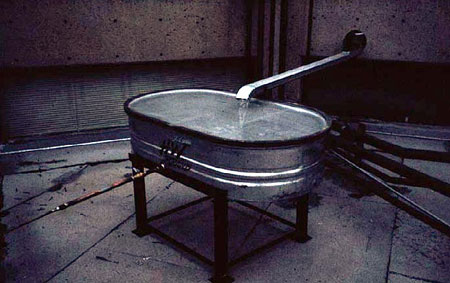
The fountain is fed from a fifty gallon galvanized steel tank on the roof of the museum which collects falling rain and snow. Water weighs about eight pounds per gallon, so when the stock tank is full, it weighs 400 pounds. If the tank fills to capacity, water will take approximately 30 hours to flow through the fountain. The water is channeled through a canalon (canal) into the tank.
"Copper tubing carries the water inside to the fountain, where it spills in three small waterfalls from one set of cast bronze hands to another, and into a stone basin. A river is etched into the surface of the middle set of arms to remind us that the arteries which flow through our bodies are also streams. On the lower set of forearms is an ancient astronomical drawing of the moon's influence on tidal waters. Overflow from the fountain streams toward a drain in the center of the patio, and it's chosen course is permanently incised into the brick floor like a dry wash on a desert landscape. From the drain, the water percolates into the ground at the back of the building and, sooner or later, rejoins the natural cycle. The sculpture's liquid music is often silent, but that is precisely when it has the most to say."
Lisa Robert, Editor, Learning From Art, "New Mexico Water Dialogue," May, 1999
"It's interesting that when functioning after a rain storm and when not filled with water, the sculpture makes a poignant comment about the importance of water to our desert community."
Ellen Landis, Curator, Albuquerque Art Museum, "Sculpture Reflects
Importance to Desert Community," Albuquerque Journal, April 18, 1999
"Sometimes artists are able to discern truth better than political systems...[Irland's] fountain in the West Patio of the Albuquerque Museum tells the truth about water in the Middle Rio Grande. The fountain demonstrates how the cycle determines the rhythm that we humans must resonate with in order to perform the dance of life dependent on water for survival...Our addictions to growth through sprawl dictate other rhythms. These are controlled by computers and bureaucrats keeping the beat to a dance macabre based on blind faith in dams, short-term technical fixes, and failure to heed falling water tables. The simple truth lies in the natural models Irland elegantly presents. The answer to the so-called water problem is in the river, the rain, the snow, and the lives of all the wild things living in the valley with us. And as 'Desert Fountain' shows us, it is also in our very own bodies, if we care to listen."
Carl Hertel, former Professor, Claremont University, California, in
an article, "Art and Truth"
In the drought summer of 1999, all fountains -- with one exception -- in New Mexico cities were required to be turned off in an attempt to conserve water.